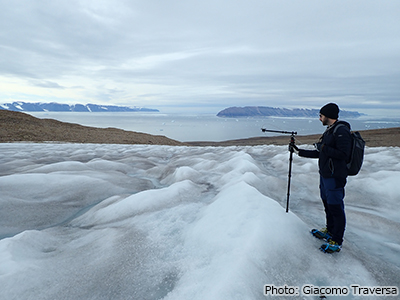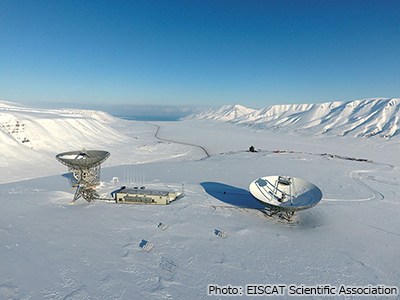International Early Career Researchers Program Report
As part of the Arctic Researchers Networking Program, Priority Subjects 1, we recruit a wide range of international early career researchers from both Arctic and non-Arctic countries who are engaged in the Arctic research, and employ or accept them at universities or research institutions in Japan. In this way, we aim to support the research of international early career researchers, stimulate mutual exchange between the Arctic researchers in Japan and international early career researchers, and strengthen the cooperative structure for international joint research.
Activity reports by international early career researchers who came to Japan under this program will be posted below.
Biological Darkening over the Qaanaaq ice cap (BDQ)
Host Researcher: Yukihiko Onuma (Japan Aerospace Exploration Agency)
Early Career Researcher (Writer): Giacomo Traversa
In this project, surface biological impurities, known as glacier algae, darkening the glacier of the Qaanaaq Ice Cap in northwestern Greenland will be analyzed using a multidisciplinary approach using satellite remote sensing, field observations and numerical modelling.
This approach will be fundamental to evaluate the evolution of surface darkening caused by their biological activities, leading to a better understanding of its effects on a glacier and the surrounding environment.
Table of Contents
Time to say goodbye (2024/3/29) New!
Seminar at the National Institute of Polar Research in Tachikawa (2024/3/11)
Meeting at the Meteorological Research Institute in Tsukuba (2024/2/26)
Ice sample analyses at the Department of Earth Sciences of Chiba University (2024/2/21)
Business trip to the Institute of Low Temperature Science, Hokkaido University (2024/2/9)
At last, ready to leave for Japan (2024/1/30)
Time to say goodbye
After two months in Japan, it is already time to say goodbye. Unfortunately, time has elapsed too quickly, but this will not be a farewell.
ArCS II has definitely provided an incredible opportunity to spend a period in a very distant country from Italy and to live a wonderful experience. This experience has certainly helped me grow as a researcher. In just two months, I had the chance to meet many eminent researchers and professors in my field of study, with whom I hope I will have the possibility to collaborate in the future. And not only this, I also had the opportunity to visit many institutions, such as the Universities of Hokkaido and Chiba, the Meteorological Research Institute of Japan, and the National Institute of Polar Research. Despite the considerable efforts spent in travelling around and building new fundamental collaborations, we managed to achieve most of the research objectives of the BDQ project, providing outstanding results which will serve as the basis for future joint research and scientific publications.
I thank ArCS II project once again for all of this and all the people who supported and helped me in achieving all these exceptional results. I am looking forward to continuing the work together once I am back home.
All the best,
Giacomo
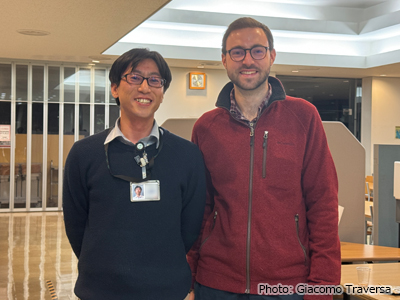
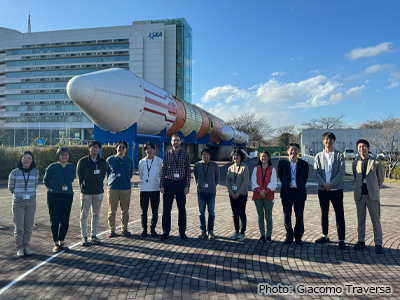
(2024/3/29)
Seminar at the National Institute of Polar Research in Tachikawa
Now that more than half of my stay in Japan has passed, I took the opportunity to give a seminar on March 6 at the National Institute of Polar Research (NIPR) in Tachikawa. After a rather long journey from Tsukuba (more than two hours by train), I arrived at the institute and met Dr. Aoki, who introduced me to the institute. After a useful seminar held by Dr. Hironori Yabuki on the NIPR “Arctic Data archive System (ADS)”, at 11 am I presented my research and the latest updates on the BDQ project to the NIPR researchers. The seminar concluded with a useful question and answer session in which useful input came up.
Then, all together with some researchers from the NIPR, we had a very pleasant lunch at the end of which I also had the chance to visit the nearby Polar Science Museum with the guidance of Dr. Aoki and Dr. Nishimura. The visit concluded with a final exchange of ideas with Dr. Aoki, talking about possible joint research efforts.
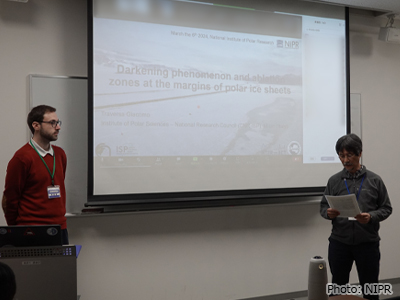
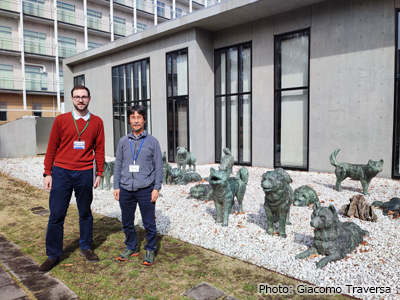
(2024/3/11)
Meeting at the Meteorological Research Institute in Tsukuba
On February 22nd, after lunchtime, we moved to the Meteorological Research Institute (MRI) in Tsukuba, not far from JAXA, for a meeting with researchers from MRI and other institutions.
Also at this meeting I had the opportunity to present my research to other Japanese colleagues with a view to future collaborations, as well as showing the recent preliminary results of the BDQ project obtained so far. On this occasion, useful and valuable ideas and suggestions emerged. After my presentation, Dr. Tomonori Tanikawa and Dr. Teruo Aoki also gave their speeches and we discussed possible meeting points of our research topics.
Once the meeting concluded, we all moved together to a restaurant, having a very pleasant dinner in a friendly atmosphere.
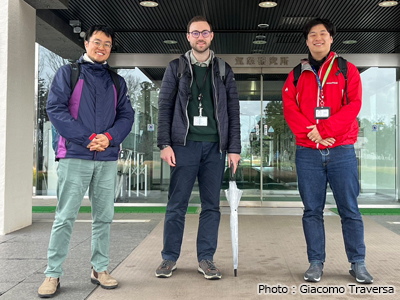
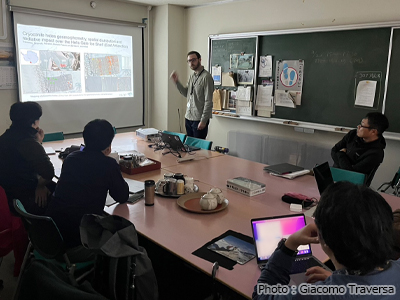
(2024/2/26)
Ice sample analyses at the Department of Earth Sciences of Chiba University
After the first few weeks of data preparation and preliminary analyses at JAXA, the turning point for the BDQ project has come. During this month I spent five days at the Department of Earth Sciences of Chiba University, working with the biogeochemistry group, led by Prof. Nozomu Takeuchi.
During the first day (14th February), I had the opportunity to present my research and the BDQ project to the group during a meeting and discuss possible interactions and collaborations with them. I was subsequently introduced to their laboratory. There, I finally had the chance to analyse surface ice samples collected on the Qaanaaq Glacier during my field campaign in August 2023. This was a crucial step for the BDQ project, as the results from these analyses are key to the continuation of the project. In detail, using a fluorescence microscope that aids cellular identification, we were able to estimate the abundance of biological matter (mainly algae) contained in the collected samples. After initial training by Dr. Onuma and Prof. Takeuchi’s group, I was able to begin the analyses which I concluded on Wednesday 21th.
These analysis results will now be compared with the corresponding field and satellite spectral reflectance measurements and will form the basis for a new methodology useful for automatically detecting the presence of algae on remote Arctic glaciers. The preliminary results thus obtained seem encouraging and I am ready to continue the project and collaborate with the biogeochemistry group of Chiba University in this context and for future collaborations.
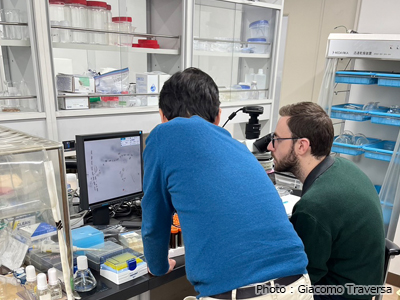
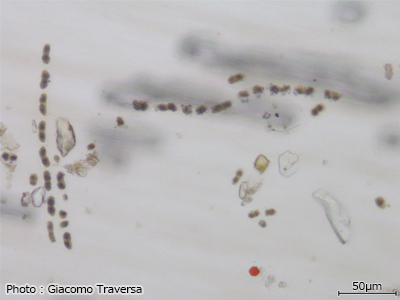
(2024/2/21)
Business trip to the Institute of Low Temperature Science, Hokkaido University
During my second week in Japan, I had the chance to visit Hokkaido University in Sapporo.
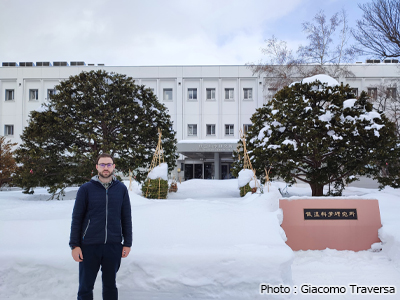
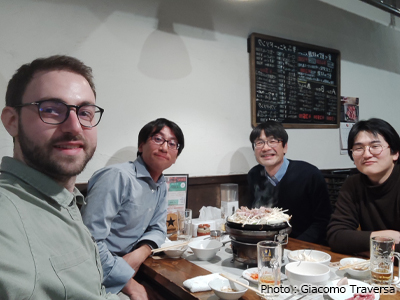
Together with Dr. Onuma we left Tokyo on the morning of February 7th and arrived in Sapporo at lunchtime. The city was completely covered in snow but, despite the cold, it was really beautiful. In the afternoon we had a prolific meeting at the Institute of Low Temperature Science of the University with the group of Prof. Shin Sugiyama, an expert in glaciology of northwestern Greenland, who has conducted numerous field campaigns in the Qaanaaq area. The day ended with a group dinner tasting the local “jingisukan”, a dish based on lamb meat. It was delicious!
The next day was dedicated to discussing with Sugiyama’s group about future joint efforts and collaborations, sharing preliminary results of our research in the BDQ project area. In the evening, we took advantage of the free time to explore the city and go to see the local snow festival, characterized by snow and ice sculptures displayed in different areas of the city.
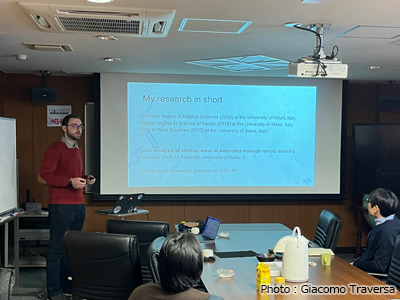
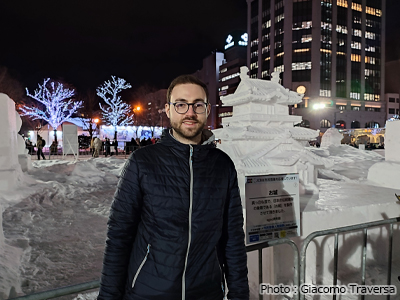
On Friday 9th it was already time to say goodbye to Prof. Sugiyama and his group, as well as the city of Sapporo and to return to Tokyo, but I am looking forward to starting this new collaboration which will certainly lead to important joint research.
(2024/2/9)
At last, ready to leave for Japan
My name is Giacomo Traversa, an Italian post-doctoral researcher, and thanks to the ArCS II International Early Career Researchers Program I have the incredible opportunity to spend two months at JAXA in Tsukuba, collaborating with researchers from this institution and from the Universities of Chiba and Hokkaido.
I left my hometown, Brugherio, a small town not far from Milan, Italy, on Sunday, January 28, 2024 on a one-hour flight to Rome, Italy. After three hours of waiting, planning the last details of the trip, I finally took the flight to Tokyo, which lasted about 12 hours via the southern route through Asia.
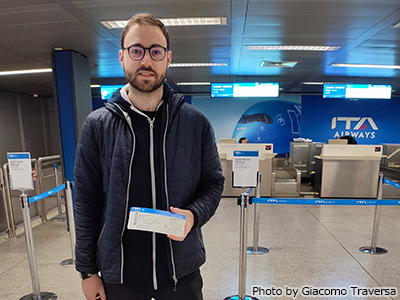
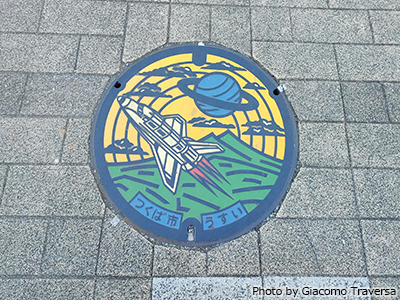
I arrived in Japan the next day, January 29th, and after an hour and a half on trains I finally arrived in Tsukuba. Now I can’t wait to get started with the project and this experience and will keep you updated with more reports during my stay here!
(2024/1/30)
Study of ion outflow in the Arctic upper atmosphere
Host Researcher: Yasunobu Ogawa (National Institute of Polar Research)
Early Career Researcher (Writer): Lindis Merete Bjoland
In this project, the observational database accumulated by the EISCAT Svalbard radar in Northern Europe and data obtained by the new EISCAT_3D radar will be analysed in combination. This will help us to understand the characteristics of the ambipolar electric field, one of the key parameters for the outflow of the Arctic upper atmosphere.
Table of Contents
Looking back on my year in Japan and the ArCS II Final Symposium (2025/3/19) New!
Trip to Tromsø and Longyearbyen (2024/8/22)
Participation in the JpGU 2024 (2024/6/4)
Radar studies of the polar atmosphere (2024/2/16)
Ready for a year in Japan (2024/1/9)
Looking back on my year in Japan and the ArCS II Final Symposium
My ArCS II project is now coming to an end, and I will be returning to Norway at the end of this month. Participating in the ArCS II International Early Career Program has been an amazing experience, allowing me to work on an exciting project and expand my network in Japan. I am deeply grateful for this experience.
A paper based on the results from the study of the ambipolar electric field has been submitted to the journal Earth, Planets and Space, and is currently under review. Over the past year in Japan, I have also had the opportunity to attend several conferences and meetings both in Japan and internationally, including JpGU, the EISCAT Symposium in Tromsø, Norway, and the 15th Symposium on Polar Science. These meetings enabled me to discuss my project with researchers from many different institutions and countries.
Finally, on March 13-14, 2025, I participated in the ArCS II Final Symposium. It was great to see the diverse range of Arctic Research covered by ArCS II participants, spanning topics such as oceans, cryosphere, atmosphere. By facilitating collaboration across disciplines, I believe ArCS II is contributing to a more comprehensive understanding of the Arctic Region. At the ArCS II final symposium, I had a poster presentation. I appreciated the chance to show my project to other participants, both during my flash talk before the poster session and through discussions with visitors to my poster.
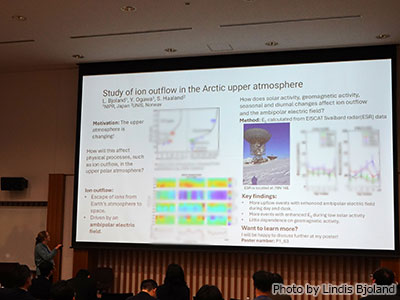
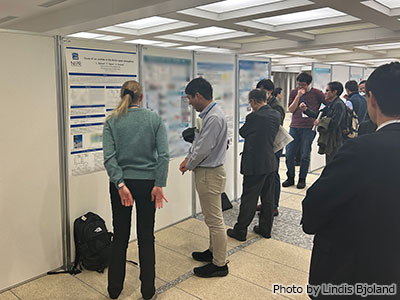
I am truly grateful for all the experiences and connections I have gained through the ArCS II program, and I look forward to staying in touch and continuing collaborations with researchers in Japan in the future.
(2025/3/19)
Trip to Tromsø and Longyearbyen
From July 29 to August 2, 2024, I got the opportunity to attend the biannual international EISCAT symposium which this time was arranged at UiT The Arctic University of Norway.
Tromsø, a municipality in northern Norway with a population of around 75000, lies above the Arctic Circle. In summer, the city experiences the midnight sun from May 18 to July 25, when the sun never sets. Conversely, the dark winters provide excellent conditions for viewing the aurora, as Tromsø is located directly beneath the auroral oval.
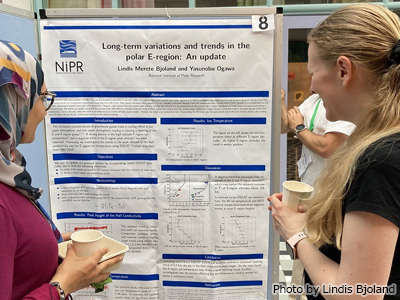
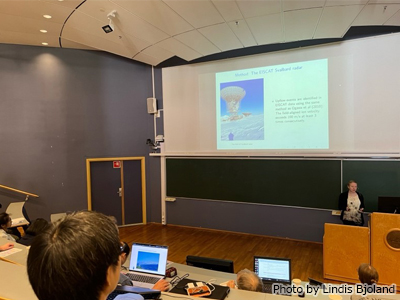
The EISCAT symposium had around 120 attendees and featured many exciting presentations on studies of the upper polar atmosphere utilizing the EISCAT radar systems. During the meeting, I had both a poster and an oral presentation, and I got the opportunity to discuss my research project with several of the other attendees. Another highlight during the symposium was an excursion to see the new EISCAT_3D radar, which has recently been built and is expected to commence operations soon. The new radar facility will open up exciting possibilities for studying the upper polar atmosphere, as it can measure the upper atmosphere in 3D with an improved spatial and temporal resolution.
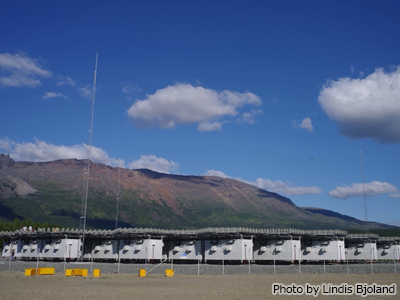
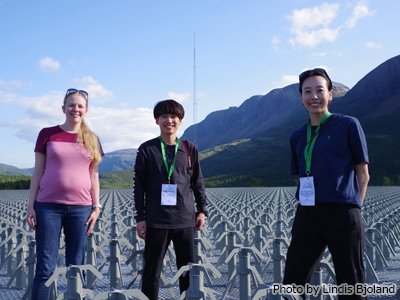
After an engaging and eventful week at the EISCAT symposium in Tromsø, I traveled even further north to Longyearbyen to attend a small workshop at the University Centre in Svalbard. Located at 78° North, Longyearbyen is one of the northernmost settlements in the world. Originally a mining town, Longyearbyen today is a centre for Arctic research, hosting several key research instruments and facilities including the EISCAT Svalbard Radar and the Kjell Henriksen Observatory.
The topic of the workshop I attended was “Moving Boundaries”, focusing on how long-term changes in the Earth’s magnetic field affect the boundaries of the auroral oval. In addition to the impact of increased greenhouse gas concentrations, long-term changes in the magnetic field can also affect the upper polar atmosphere. I found it particularly interesting to learn more about this topic, as my current research involves studying how climate change affects the upper polar atmosphere.
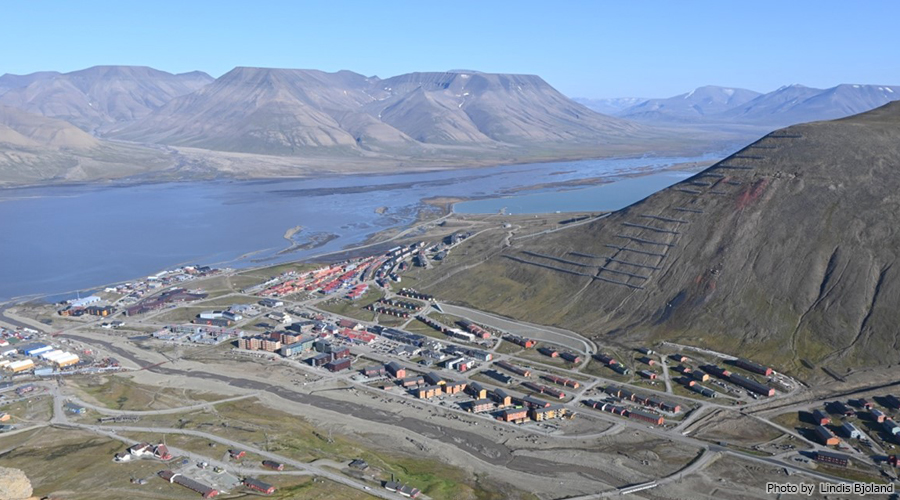
After two inspiring weeks in Tromsø and Longyearbyen, I returned to Tokyo and NIPR on August 11, eager to continue my research with the new perspectives gained from my trip.
(2024/8/22)
Participation in the JpGU 2024
Last week I had the opportunity to participate in the Japan Geoscience Union (JpGU) meeting, held at Makuhari Messe from 26-31 May 2024. JpGU is one of the largest meetings I have ever attended with several parallel sessions and thousands of participants from Japan and abroad.
During the meeting, I attended many interesting sessions on topics such as space weather and space climate, coupling processes in the atmosphere-ionosphere system, study of coupling processes in the solar-terrestrial system, and many more! I had the chance to listen to many exciting talks and engage in insightful discussions at various poster presentations.
On Wednesday, 29 May, I presented some preliminary results from my ArCS II project on the ambipolar electric field. I was a bit nervous since it was my first time presenting these results publicly, but I think my presentation went smoothly. All in all, attending JpGU has been a great experience for me and I learnt a lot from interacting with everyone I met at the meeting.
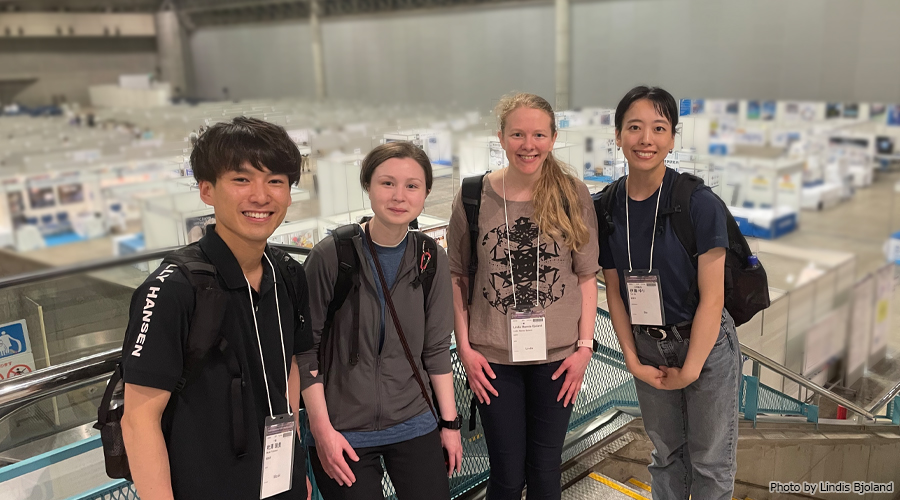
(2024/6/4)
Radar studies of the polar atmosphere
My first month at NIPR has come to an end, and in this report, I would like to share a bit more with you what I am working on during my stay in Japan.
In the polar region a stream of ions is flowing out of the upper atmosphere and disappear into space, a process often referred to as the polar wind. The ions are extracted from the upper atmosphere by what is known as an ambipolar electric field. This process has strong effects on the polar atmosphere as the escaping ions on short time scales can affect space weather events and on long time scales will influence the evolution of the atmosphere. Despite its importance, fundamental aspects of the ambipolar electric field are not well understood. In my project we use data from the EISCAT Svalbard radar, located in the Arctic at 78°N, to do an in-depth analysis and comparison of a selection of events where this kind of upflow is observed. This will help us to understand which factors affects the ambipolar electric field and thus the polar wind.
While the lower part of our atmosphere is getting warmer, the increased concentration of greenhouse gases is leading to a cooling of the upper atmosphere. This cooling also causes the upper atmosphere to contract, possibly affecting processes occurring in this part of the atmosphere. In parallel with the study of the polar wind, we are therefore also investigating how upper atmospheric cooling is affecting parameters and processes in the upper polar atmosphere, including possible effects on the polar wind which originates in this region of the atmosphere. In this study we also use long-term data from the EISCAT radar.
So far I have really enjoyed my stay in Japan, and I look forward to share more about my project and its results with you in the future.
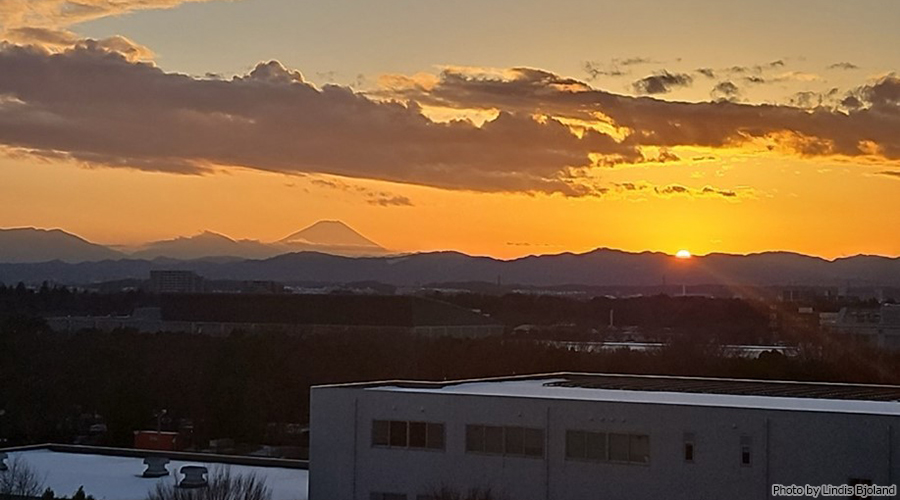
(2024/2/16)
Ready for a year in Japan
My name is Lindis Bjoland and through the ArCS II International Early Career Researchers Program I got the opportunity to travel to Japan to collaborate with researchers at NIPR.
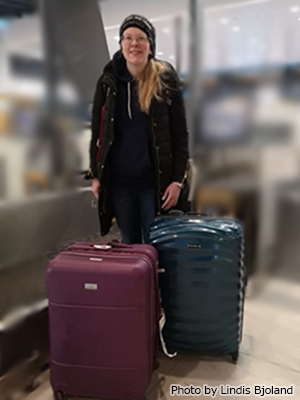
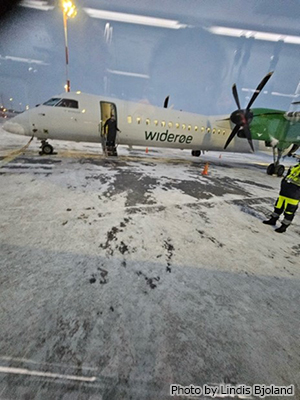
After packing two suitcases, it was time for departure from my hometown Bergen, Norway on Thursday, January 4, 2024. A two-hour flight took me to Helsinki, Finland and after a few hours waiting time in Helsinki it was time for the next flight which took me directly from Helsinki to Tokyo in about 13.5 hours. During the flight from Finland to Japan we crossed the North Pole!
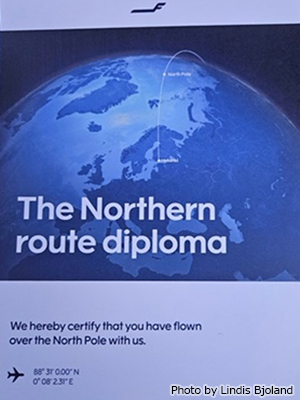
I finally arrived at NIPR Friday evening approx. 24 hours after leaving Bergen. Now I am excited to start working on the project and I will keep you updated with more reports during my stay here!
(2024/1/9)

